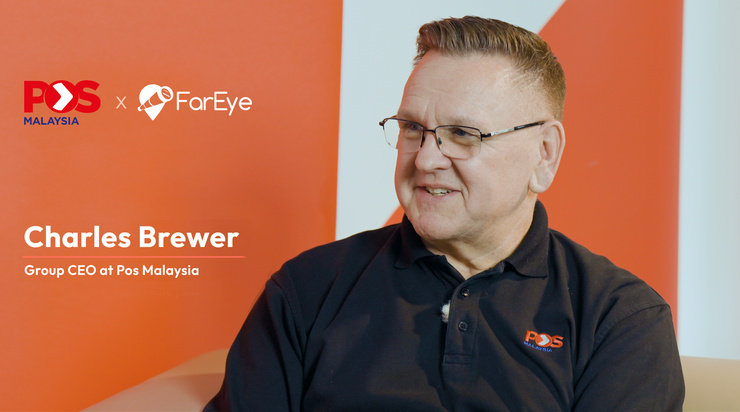- Last-Mile
Struggling to Scale? The Case for Rethinking Your Last mile Courier Approach
Table of Contents
- Why Your Courier Model Needs a Reset
- Challenges Associated With Scaling Last mile Courier Operations
- Indicators That Your Existing last mile courier Strategy May Be Limiting Growth
- Last‑mile Courier Tracking Challenges and Solutions
- Competitive Benchmarking of Leading Courier‑platform Vendors
- Case Study: How an African Retail Leader Doubled Volume and Lifted NPS With FarEye
- Essential Capabilities Of a Modern last mile courier Solution
- Strategic Approaches to Rethinking Your last mile courier Model
- Preparing for a Scalable and Future-ready last mile courier Operation
- FAQs

For everyone involved in the last mile delivery space, including enterprise leaders, supply chain managers, dispatchers, and frontline teams, meeting growing demand is now a core business challenge. As businesses work to satisfy rising customer expectations, the requirements on last mile courier networks continue to increase.
The worldwide last mile delivery market is expected to reach USD 367.96 billion by 2034, growing at a CAGR of 8.84%. This steady rise underscores the critical role of efficient last mile courier operations in achieving long-term business success.
As order volumes climb, many companies find that their existing systems cannot keep pace. Manual processes, fragmented tracking, and rising costs begin to impact both daily efficiency and customer satisfaction. Let us examine the key challenges that arise when last mile courier operations exceed their initial capacity.
Why Your Courier Model Needs a Reset
Legacy workflows may have worked when volumes were small, but growth exposes new gaps that a traditional framework cannot close. When you oversee thousands of weekly drops, even a tiny hiccup can escalate quickly and ripple across the entire delivery network.
A modernized last‑mile courier framework replaces one‑off fixes with repeatable, data‑driven workflows. Robust last‑mile courier tracking underpins each of the upgrades below, ensuring every change is measurable and sustainable.
- Fragmented Data Hinders Fast Decisions
Order, inventory, and fleet information sit in separate portals, leaving planners without a single source of truth. The absence of synchronized insights slows multi‑carrier orchestration and limits delivery resilience during peak periods. - Traditional Assignments Inflate Operating Costs
Fixed driver territories and rigid vehicle pairings produce empty miles when demand shifts. Without dynamic courier assignment, overtime and fuel spend rise faster than revenue. - Limited Real‑time Visibility Masks Service Failures
Gaps in last‑mile courier tracking prevent early detection of traffic delays, missed scans, or regulatory holds. Hidden exceptions translate into late arrivals and costly manual follow‑ups. - Inconsistent Performance Across Carriers
Each contracted fleet follows its own playbook for updates and proof‑of‑delivery. This variability complicates Service Level Agreement (SLA) enforcement and makes it difficult to compare true costs across providers. - Escalating Customer Expectations Outpace Legacy Tools
Same‑day windows, precise Estimated Time of Arrivals (ETAs), and instant status changes are now standard. Older platforms cannot provide the detailed milestones that modern shoppers view as basic service. - Rising Compliance and Sustainability Pressures
Urban access fees, emissions caps, and electronic documentation mandates demand detailed trip records. Disconnected systems struggle to compile evidence when regulators or clients request proof. - Lack of Predictive Insights Blocks Strategic Growth
Historical data is siloed, making it hard to spot volume trends or plan capacity expansions. Without clear analytics, long‑term investment decisions remain educated guesses rather than data‑driven strategies.
Together, these factors indicate that a traditional courier setup is likely to incur higher costs, exhibit weaker customer loyalty, and experience stalled expansion. A reset built on reliable last‑mile courier tracking and flexible technology foundations is critical for sustained delivery resilience in a competitive market.
Challenges Associated With Scaling Last mile Courier Operations
Scaling a last‑mile courier network often amplifies hidden operational flaws. Fragmented systems, sudden demand spikes, and rising cost pressures can quickly overwhelm processes that once handled smaller volumes with ease.
- Fragmented Systems and Manual Processes
When each new region adds its portal, the last mile courier workflow fragments. Manual spreadsheets, slow dispatch, and outdated last mile courier tracking force agents to search for status details. Data re-entry introduces errors that ripple into wrong addresses and missed pickups. Service desks then chase fixes, raising the cost per delivery.
- Fluctuating Demand and Volume Spikes
Holiday peaks overload traditional rosters. Fleets either pay for idle trucks or chase subcontractors at premium rates. Without responsive last mile courier tracking, managers cannot predict real-time capacity gaps. Late reallocations create driver overtime and erode customer trust.
- Rising Costs and Margin Pressures
Fuel, wages, and congestion fees continue to increase annually. A scattered last mile courier network results in empty miles and manual reroutes. Inefficient paths that are hidden by limited last mile courier tracking drive fuel spending higher each quarter. Margin pressure increases when repeat deliveries consume time that could be used to fulfill new orders.
Indicators That Your Existing last mile courier Strategy May Be Limiting Growth
Early warning signs often surface before serious failures. Recognizing these signals helps leaders recalibrate the last mile courier model and refine last mile courier tracking before growth stalls.
- Persistent Delivery Delays and Unmet Customer Expectations
SLAs slip even as the fleet size grows. Non-dynamic ETAs suggest that last mile courier tracking often lacks real-time accuracy, leading to missed delivery windows and increased refund requests. Customer care teams then spend hours fielding avoidable complaints instead of driving loyalty. - Variability in Service Quality Across Different Regions
Some hubs hit first-attempt delivery success targets while nearby zones struggle. This disparity points to inconsistent last mile courier rules and uneven last mile courier tracking across carriers. Uneven service decreases brand reputation and complicates expansion planning. - Limited Visibility and Insufficient Control Over Deliveries
Dispatchers who cannot locate a parcel quickly lack live last mile courier tracking. Without that view, proactive fixes stall, and unresolved delays raise cost-to-serve for every last mile courier run. Escalations then consume management time and budget. - Challenges in Achieving Sustainability and Regulatory Compliance
Emissions caps and packaging rules require granular trip data. A patchy last mile courier tracking setup makes carbon reporting slow and unreliable, risking fines and reputational damage for the entire last mile courier network. Consistent data is essential to prove progress and secure stakeholder trust.
Last‑mile Courier Tracking Challenges and Solutions
As shipment volumes grow, visibility gaps, cost spikes, and service misses can surface without warning. The table below pairs the most common pain points with practical fixes, enabling teams to strengthen tracking, reduce risk, and protect customer satisfaction.
| Challenge | Targeted Solution |
| Fragmented data slows multi‑carrier orchestration | Merge order, fleet, and inventory feeds into one control tower with real‑time last‑mile courier tracking |
| Fixed driver zones create empty miles | Introduce dynamic courier assignment driven by AI route engines |
| Hidden delays hurt service levels | Use live dashboards and alerts to reroute vehicles before ETAs slip |
| Uneven Proof-of-delivery (POD) across carriers | Standardize digital POD capture for consistent SLA compliance |
| Customers require tighter windows | Offer self‑service portals with live ETAs and on‑the‑fly rescheduling |
| New urban fees and emissions caps | Add sustainability dashboards that model EV routes and track CO₂ output |
| Limited analytics for growth planning | Apply predictive volume forecasts to guide depot placement and staffing |
Competitive Benchmarking of Leading Courier‑platform Vendors
Selecting the right technology partner requires a clear understanding of how each platform addresses core last mile needs. The comparison below summarizes the key capabilities of four well-known vendors, alongside a reference row for FarEye, to help logistics leaders identify where solutions converge and where they differ.
FarEye combines multi‑carrier orchestration, dynamic courier assignment, and end‑to‑end delivery resilience. Our low-code workflow engine enables enterprises to adapt processes without writing custom code, while sustainability dashboards support carbon-reduction targets. These capabilities give FarEye a distinctive edge when large networks need both agility and strict governance.
| Provider | Core Capabilities (selection) |
| FarEye | AI‑powered route optimization, real‑time control tower, workflow builder, sustainability dashboards, multi‑language interfaces |
| ClickPost | Carrier integrations, real‑time shipment tracking, and automated Non‑delivery Report (NDR) handling |
| OnFleet | Automated dispatch, route optimization, SMS notifications |
| Routific | Route optimization, dynamic dispatching, and real‑time tracking |
| OptimoRoute | Route planning and optimization, real‑time driver tracking, cloud scheduling, and analytics |
Case Study: How an African Retail Leader Doubled Volume and Lifted NPS With FarEye
Africa's second-largest retail group, known for high-volume and low-cost operations, faced sharp growth pains when shipment volumes doubled in one year. Manual carrier orchestration, limited visibility, and slow partner onboarding drove up the cost per delivery and pushed the Net Promoter Score (NPS) down.
By deploying FarEye's multi-carrier parcel-management solution (MCPMS), the retailer consolidated data, automated decisions, and turned last mile delivery into a growth enabler.
- Achieving Seamless Carrier Onboarding and Integration
Poor integration with multiple carriers had raised costs, disrupted service, and hampered visibility. FarEye's API-driven onboarding, automated rate shopping, and carrier performance monitoring ensured optimal delivery selection for every shipment. The retailer quickly identified its top courier partners and distributed rising order volumes to those delivering the largest loads for the company. - Enhancing First-attempt Delivery Rates and Visibility
FarEye's exception-management alerts and deeper shipment-event insights enabled the retailer to achieve industry-leading first-time delivery rates in the region. Automated dispatch matched every parcel to the best last mile courier. The First-attempt Delivery Rate (FADR) increased by 5%, while continuous last mile courier tracking updates reduced WISMO inquiries and improved overall shipment awareness. - Reducing Per-delivery Cost and Improving Customer NPS
Dynamic carrier load balancing reduced the trimmed distance per stop by 18% and lowered fuel usage. Branded tracking pages and milestone-based notifications lifted Customer NPS by 15 points.
"FarEye helped them reduce delivery costs by 3% even as shipment volume doubled, achieving a leaner cost-per-delivery while supporting rapid growth," says Africa's second-largest retail group - Automating Performance Monitoring and Exception Management
Advanced KPI dashboards now provide order-to-door parcel visibility. Real-time exception alerts trigger timely corrective actions, protecting service levels and supporting continuous improvement across all courier partners.
Far‑reaching gains are easiest to trust when numbers back them. Below is a snapshot of the KPI improvements enterprises have recorded after modernizing their last‑mile courier networks. One standout example comes from an African retail leader who partnered with FarEye, reducing delivery costs by 3% while doubling volume, demonstrating that scale and savings can coexist.
| KPI | Benchmark Achieved | Context |
| First‑attempt delivery rate (FADR) uplift | +5 percentage points | Achieved through dynamic carrier orchestration and real‑time visibility |
| Cost reduction per delivery | 3 % decrease | Realized even as shipment volume grew 100 %, demonstrating efficiency at scale |
| NPS lift | +15 points | Driven by branded tracking pages, proactive alerts, and faster deliveries |
These metrics highlight how data‑driven routing, live tracking, and automated exception management translate directly into better customer experiences and healthier margins.
Essential Capabilities Of a Modern last mile courier Solution
Modern last mile delivery is no longer just about route planning; it's also about optimizing the customer experience. It requires platforms that can automate key workflows, maintain real-time visibility, and support dynamic growth. The capabilities outlined below define a reliable last mile courier platform that ensures efficient operations and keeps customers informed.
- Comprehensive Automation and Intelligent Dispatching
Automation should begin the moment an order is received. The system must support rapid scanning, sorting, and label generation while automatically allocating each job to the most suitable last mile courier.
Intelligent dispatching ensures that decisions are based on cost, service level, and delivery zone, all without manual intervention. Integrated last mile courier tracking then keeps planners, drivers, and customers updated through a unified view. - Real-time Tracking and Proactive Customer Communication
Every delivery should be visible in real-time through GPS-enabled tracking. Driver handsets stream continuous GPS signals to a digital control tower, powering live last mile courier tracking and single-click location views.
Milestone notifications are sent automatically via SMS, WhatsApp, or email, while chatbots handle routine queries. Predictive alerts flag potential delays early, enabling support teams to act and allow teams to act before a delay impacts service. As emerging trends like autonomous delivery gain traction, the same tracking layer will monitor both human‑driven and autonomous assets, preserving service consistency. - AI-driven Route Optimization and Dynamic Rescheduling
Advanced routing engines powered by machine learning should account for traffic, weather, and historical data. When a road closes or demand surges, dynamic rescheduling recalculates stops in seconds and refreshes ETAs and last mile courier tracking links for every stakeholder.
Support for EV routing and sustainability reporting adds long-term value by reducing emissions and improving compliance. The engine also factors in micro‑fulfillment integration, directing inventory to local hubs that shorten routes and cut costs. - Scalable System Architecture Aligned With Business Growth
An enterprise-grade, cloud-native stack scales automatically during seasonal peaks, preserving low-latency dispatch and continuous last mile courier tracking. Workflow configurability enables teams to adapt processes without requiring code changes, while multi-language interfaces broaden adoption.
Open APIs connect WMS, OMS, TMS, POS, and payment systems. Forthcoming blockchain track-and-trace modules will add immutable audit trails, enhancing security and compliance as new geographies, fleets, and partners come online.
Strategic Approaches to Rethinking Your last mile courier Model
Even the most advanced platform delivers only part of the value; the rest comes from sound operating strategies. These approaches demonstrate how enterprises can maintain a flexible, resilient, and customer-centric last mile courier network as volume and complexity increase.
- Integration of Third-party Logistics for Enhanced Flexibility
Blending owned vehicles with specialized 3PL partners creates instant surge capacity without permanent overhead. A unified control tower selects the right last mile courier for each stop, balancing cost and service level.
Because all partners feed into the same last mile courier tracking view, planners retain end-to-end visibility and can shift loads in real-time when demand spikes or routes change. - Utilization of Data and Analytics for Informed Decision-making
Live dashboards surface delay hotspots, cost anomalies, and weak signals in last mile courier tracking data. Operations teams can review road-level metrics and then decide whether to add lockers, open micro-hubs, or adjust cut-off times.
Advanced analytics also model fuel burn and dwell time, enabling smarter procurement and continuous improvement across every last mile courier lane. - Establishing a Resilient Network With Multi-modal Delivery Options
Bikes, vans, and parcel lockers all plug into a single orchestration layer. Each mode appears as a virtual last mile courier node, so consistent last mile courier tracking is preserved regardless of vehicle type.
Multi-modal routing mitigates congestion fines in city centers. It reduces the cost per stop in low-density rural zones, creating a balanced network that withstands weather events and labor shortages. - Emphasizing Customer Experience at all Touchpoints
Modern shoppers value control as much as speed. Self-service portals let recipients reschedule or reroute their last mile courier window without calling support, and branded notifications share precise ETAs through the same last mile courier tracking feed used by dispatchers. Transparent updates reduce anxiety, cut WISMO calls, and strengthen loyalty, all while lowering service desk costs.
Preparing for a Scalable and Future-ready last mile courier Operation
Scaling logistics demands more than adding trucks. Enterprises need unified workflows, live analytics, and dependable last mile courier tracking that guides every choice. Replacing spreadsheets and isolated portals with intelligent routing and predictive visibility allows networks to absorb peak demand without squeezing margins.
At the same time, multi-modal capacity, accurate emissions reporting, and self-service tools boost resilience, compliance, and loyalty. Clear KPIs convert anecdotal problems into measurable wins, supporting continuous optimization.
FarEye unites intelligent dispatch, rapid carrier onboarding, and real-time control-tower metrics in one cloud platform. The system scales during surges and reroutes loads within minutes while streaming performance data to finance, operations, and ESG teams. For an assessment of your last mile courier network, contact FarEye today.
FAQs
How quickly can I integrate new courier partners?
FarEye’s open APIs and pre‑configured carrier connectors let you add new partners in a fraction of the time required by traditional methods. Most national and regional fleets can be activated through a streamlined credential‑mapping process, supported by automated testing sandboxes. This rapid onboarding keeps growth initiatives on schedule and prevents lengthy IT backlogs.
Does tracking data feed into my ESG reports?
Yes. FarEye consolidates every scan, GPS ping, and delivery milestone into a unified data lake that tags distance traveled, service mode, and fuel type. These records flow directly into sustainability dashboards and export to common ESG frameworks (such as GRI or CDP), giving finance and compliance teams auditable, near‑real‑time emission metrics alongside operational KPIs.
Sources:
https://www.towardsautomotive.com/insights/last-mile-delivery-market-sizing
https://fareye.com/resources/case-studies/africa-leading-retailer

Komal Puri is a seasoned professional in the logistics and supply chain industry. As the AVP of Marketing and a subject matter expert at FarEye, she has been instrumental in shaping the industry narrative for the past decade. Her expertise and insights have earned her numerous awards and recognition. Komal’s writings reflect her deep understanding of the industry, offering valuable insights and thought leadership.
Let's Talk to Our Experts and Optimize Your Deliveries Today!
An expert from our team will reach out within 24 hours

